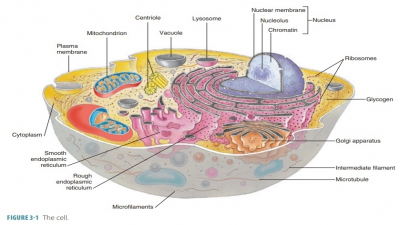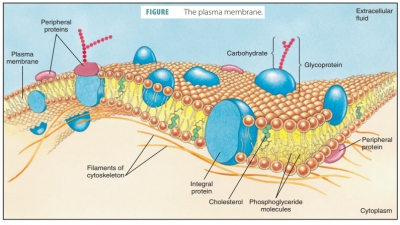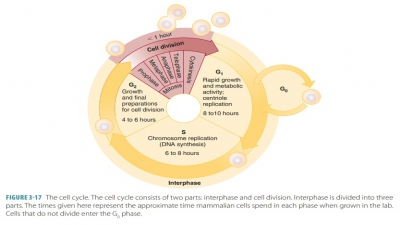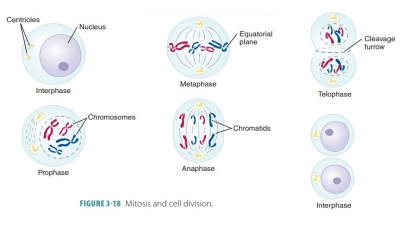Structure of Nucleus
| Home | | Anatomy and Physiology | | Anatomy and Physiology Health Education (APHE) |Chapter: Anatomy and Physiology for Health Professionals: Levels of Organization : Cells
1. How does the nucleus control the activities of a cell? 2. What is chromatin? 3. What is the nuclear envelope?
Nucleus
The nucleus is the largest, most visible organelle inside a cell. The nucleus
serves as the control center for cellular operations. It contains DNA or
genetic material that controls cell activities. A single nucleus stores all
required information that directs the synthe-sis of the 100,000 proteins in the
human body. A cell without a nucleus cannot repair itself, disintegrating
within 3 to 4 months. The nucleus contains the genetic instructions needed to
synthesize the proteins that determine cell structures and functions. These
instruc-tions are stored in the chromosomes. These structures consist of DNA
and various proteins that control and access genetic information. Most cells
contain a sin-gle nucleus, with the exception of skeletal muscle cells (with
numerous nuclei) and mature red blood cells (with no nuclei). Along DNA
strands, information is stored in a sequence of nitrogenous bases, which include adenine (A), thymine (T), cytosine (C), and guanine (G). Genes are the functional units of DNA.
The nucleus of a cell is usually
round and is enclosed in a double nuclear
envelope, with inner and outer lipid
membranes. This envelope also has a protein lining, allowing certain molecules
to exit the nucleus. Communication between the nucleus and cytosol occurs
through nuclear pore complexes, which are large protein complexes that have a central channel. Ions
and small molecules move freely through the cen-tral channel while it is open.
However, large molecules (proteins, RNA, etc.) require energy for their
transport process. Inside the nucleus is a fluid called nucleoplasm that suspends the following structures:
■■ Nucleolus: A transient “mini nucleus” made upmostly of RNA, enzymes,
and protein molecules are called histones;
nucleoli have no surrounding membranes. Ribosomal RNA forms in the nucleo-lus,
and ribosomes and their subunits migrate out to the cell’s cytoplasm via
carrier-mediated trans-port at the nuclear pores. Nucleoli form around parts of
DNA containing instructions for produc-ing ribosomal proteins and RNA as these
processes are occurring. The nucleoli are prominent in cells making large
amounts of proteins, which include those of the liver, muscles, and nerves,
since these cells require large amounts of ribosomes. When stained, nucleoli
appear dark in color.
■■Nucleosome: Nuclear DNA stores instructions for protein synthesis. Each
molecule of DNAs thousands of genes and holds informationrequired to synthesize
thousands of proteins.The DNA interacts with histones to help determine
information that can be supplied to the cellwhen needed. The chemical
“language” used bycells is called the genetic code. The genetic codeis a
triplet code because of its sequence of threenitrogenousbases that specifies a
single aminoacid. At certain intervals, strands of DNA wind around the
histones to form a complex called cleosome. This winding allows more DNA tofit
in smaller spaces. Chains of nucleosomes maycoil around various proteins. The
amount of coiling is based on whether cell division is occurring.
Chromatin:Loosely coiled DNA andproteinfibers that condenseforming chromosomes(FIGURE
3-12). The DNA controls proteinsynthesis, and when the cell starts to divide,
the chromatin fibers coil tightly to form the chro-mosomes. Chromatin
causes a cell nucleus to have a grainy, clumped appearance.
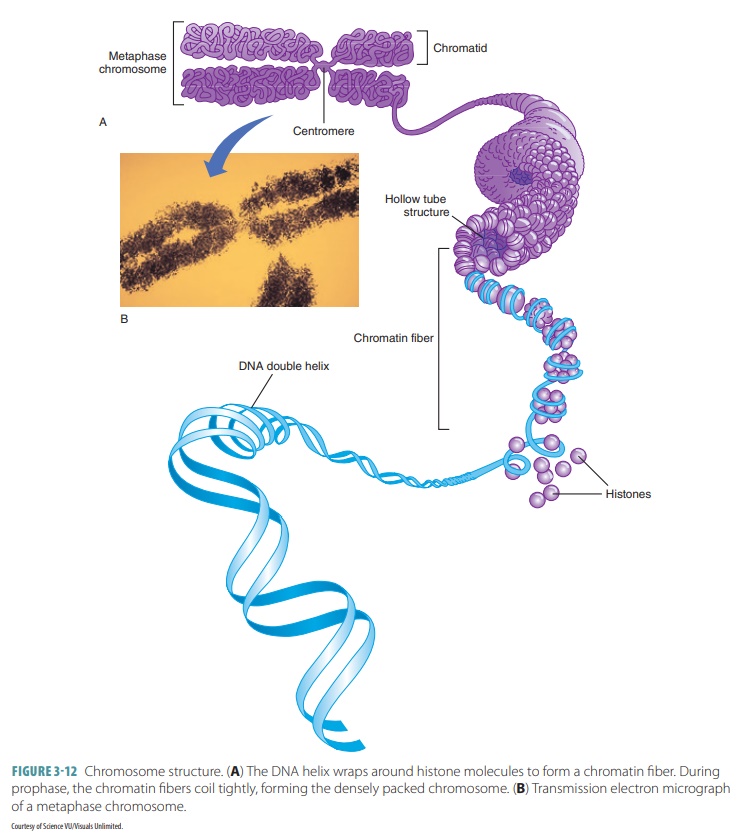
Gene Activation in Protein Synthesis
Genes are kept inactive by bound
histones, and in order for a gene to affect a cell, the histones must be
tempo-rarily removed. The part of the DNA molecule contain-ing that gene can
then uncoil. This partially understood process is called gene activation. Every
gene has seg-ments that regulate its own activity. These segments are
nitrogenous-based triplets. Signals from the triplets that control activities
form regions known as controlsegments or promoters at the start of each gene.
Everygene ends with a “stop” signal. Temporary disruption of weak hydrogen
bonds between nitrogenous bases of two DNA strands, followed by the removal of
the his-tone guarding the promoter, results in gene activation.
Then, the enzyme called RNA polymerase binds to
the promoter. This is the first step intranscription, in which all three types of RNA are synthesized from a DNA template.
Transcription is the copying or rewrit-ing of information. The most important
type of RNA to understand is called messenger RNA or mRNA. It carries the
information required to synthesize proteins. Its synthesis is essential since
DNA cannot leave the cell nucleus. Information is copied to mRNA, which leaves
the nucleus, carrying information to the cytoplasm, where protein synthesis
occurs.
Translation
When protein
synthesis occurs, functional poly-peptides
are assembled in the cytoplasm. It occurs through translation, which is the forming of a linear amino acid chain. It uses information
from an mRNA strand. Messages from nucleic acids are translated by the
ribosomes so that they can be utilized by proteins. Every mRNA codon designates a certain amino acid
to be put into the polypeptide chain. The amino acids are provided via transfer RNA or tRNA,
which is comparatively small and mobile. The molecules of tRNA bind and deliver
a specific amino acid. There are more than 20 types of tRNA—at least one for
each amino acid used in protein synthesis.
Molecules of tRNA have tails that
bind amino acids. At approximately the middle section, a nucle-otide chain of
tRNA forms a tight loop. This loop can interact with a strand of mRNA. In the
loop are three nitrogenous bases, which form an anticodon. During translation, there is complementary bonding of the anticodon
with an appropriate mRNA codon. The anticodon’s base sequence indicates which
type of amino acid is carried by the tRNA. The moleculesof tRNA provide a
physical link between codons and amino acids. During translation, every codon
in the mRNA strand binds a complementary anticodon on a molecule of tRNA. The
sequence of amino acids in the polypeptide chain is based on the arrangement of
codons on the mRNA strand.
The process of translation can
produce a typi-cal protein in approximately 20 seconds. The mRNA strand stays
intact and is able to interact with other ribosomes. It can also create extra
copies of the same polypeptide chain. After a few minutes or hours, the mRNA
strands are broken down and there is recycling of the nucleotides. Large
numbers of protein chains can be produced simultaneously. Though the entire
strand can have thousands of codons, only two mRNA codons are examined by a
ribosome at one time. Therefore, many ribosomes can bind to just one mRNA
strand.
At a single moment, each ribosome
examines a different part of the same overall message. Each of them will construct
a copy of the same protein as the other ribosomes. A polyribosome, also called a poly-some,
is a series of ribosomes that are attached to thesame mRNA strand.
Nuclear Control of Cell Structure and Function
In a cell’s nucleus, the DNA
directs specific protein synthesis and is able to control almost all variable
of cell structure and function. The nucleus has two levels of control:
■■ Direct control: over
structural protein synthesis,including cytoskeletal components, receptors, and
other membrane proteins, and secretory products. Via instructions in mRNA
strands, the nucleus can change the internal structure of the cell, its
sensitivity to environmental substances, and its secretory functions.
■■ Indirect control: over all
other factors of cellularmetabolism. This occurs by regulation of enzyme
synthesis. All metabolic activities and cell func-tions can be regulated when
the nucleus orders or stops production of certain enzymes. One exam-ple is when
the nucleus speeds up glycolysis by increasing certain enzymes in the
cytoplasm.
Often, gene activation or
deactivation is trig-gered by cytoplasmic changes. The nucleoplasm may be
sufficiently affected to turn certain genes on or off. Oppositely, hormones or
messengers can enter the nucleus through nuclear pores, binding to specific
promoters or receptors on the DNA strands. Therefore, continued but relatively
selective chemi-cal communication occurs between the nucleus and cytoplasm.
This selectivity is due to the restrictiveactions of the nuclear pores and the
barrier of the nuclear envelope. Communication also continues between the
cytoplasm and extracellular fluid, across the plasma membrane. Certain
communications may later alter gene activity.
1. How
does the nucleus control the activities of a cell?
2. What is
chromatin?
3. What is
the nuclear envelope?
Related Topics
